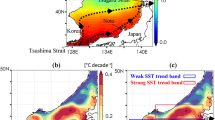Abstract
The drift trajectory of a floe near the North Pole (87° N, 175° W) was observed during 8–19 August, 2010 based on the fourth Chinese National Arctic Research Expedition. The trajectory of the floe showed circular motions superimposed on straight drift. Each cycle had a period of about 12 h. The circular motion is inertial oscillation. The largest amplitude of inertial oscillation speed can reach 20 cm/s. After removing the inertial oscillation, the floe drift direction is about 40° on average to the right of the observed 10-m wind which is much larger than previous reports on the angle between sea-ice velocity and the geostrophic wind, and floe drift moves with a speed of about 1.4 % of the observed 10-m wind speed throughout the whole observation period. A simple dynamic sea ice-ocean coupled model and a three-dimensional sea ice-ocean coupled model are employed to simulate the floe drift. Both numerical models are with the widely used quadratic water-drag formulation, i.e., the stress is proportional to the square of the ice velocity relative to the ocean surface current. The inertial oscillation of the floe is successfully simulated by the simple passive drag model, while the floe drift amplitudes simulated from the three-dimensional model are relatively small.









Similar content being viewed by others
References
Day CG, Webster F (1965) Some current measurements in the Sargasso Sea. Deep See Res 12:805–814
Dee DP, Uppala SM, Simmons AJ et al (2011) The ERA-Interim reanalysis: configuration and performance of the data assimilation system. Q J R Meteorol Soc 137:553–597. doi:10.1002/qj.828
Ekman VW (1905) On the influence of the Earth’s rotation on ocean-currents. Arkiv for Matematik, Astronomi och Fysik 2(11):1–52
Fukamachi Y, Ohshima KI, Mukai Y, Mizuta G, Wakatsuchi M (2011) Sea-ice drift characteristics revealed by measurement of acoustic Doppler current profiler and ice-profiling sonar off Hokkaido in the Sea of Okhotsk. Ann Glaciol 52(57):1–8
Griffies SM, Harrison MJ, Pacanowski RC, Rosati A (2004) A technical guide to MOM4. NOAA/Geophysical Fluid Dynamics Laboratory, Princeton, p 337
Hibler WD III (1979) A dynamic thermodynamic sea ice model. J Phys Oceanogr 9:815–846
Hunkins K (1967) Inertial oscillations of Fletcher’s ice island (T-3). J Geophys Res 72(4):1165–1174
Khandekar M (1980) Inertial oscillations in floe motion over the Beaufort Sea—observations and analysis. Atmosphere-Ocean 18(1):1–14
Kimura N, Wakatsuchi M (2000) Relationship between sea-ice motion and geostrophic wind in the northern hemisphere. Geophys Res Lett 27(22):3735–3738
Kwok R, Cunningham GF, Hibler WD III (2003) Sub-daily sea ice and deformation from RADARSAT observations. Geophys Res Lett 30(30):2218–2221
McPhee MG (1978) A simulation of inertial oscillation in drifting pack ice. Dynam Atmos Oceans 2(2):107–122
Morison J, Goldberg D (2011) A brief study of the force balance between a small iceberg, the ocean, sea ice, and atmosphere in the Weddell Sea. Cold Regions Sci Tech 76–77:69–76
Reynolds M, Pease CH, Overland JE (1985) Ice drift and regional meteorology in the Southern Bering Sea: results from MIZEX West. J Geophys Res 90(C6):11,967–11,981
Thorndike AS, Colony R (1982) Sea ice motion in response to geostrophic winds. J Geophys Res 87(C8):5845–5852
Winton M (2000) A reformulated three-layer sea ice model. J Atmos Ocean Tech 17(4):525–531
Acknowledgments
This work is supported by the Project of Comprehensive Evalution of Polar Areas on Global and Regional Climate Changes (CHINARE2012-04-04), the 973 Project (no. 2010CB950300), the Key Project of the National Natural Science Foundation of China (no. 40730842), the National Oceanic Public Welfare Project (no. 201205007-4), and the Scientific Research Foundation of the First Institute of Oceanography, State Oceanic Administration (no. 2011T02).
Author information
Authors and Affiliations
Corresponding author
Additional information
Responsible Editor: Bo Qiu
This article is part of the Topical Collection on the 3rd International Workshop on Modelling the Ocean 2011
Rights and permissions
About this article
Cite this article
Shu, Q., Ma, H. & Qiao, F. Observation and simulation of a floe drift near the North Pole. Ocean Dynamics 62, 1195–1200 (2012). https://doi.org/10.1007/s10236-012-0554-4
Received:
Accepted:
Published:
Issue Date:
DOI: https://doi.org/10.1007/s10236-012-0554-4




